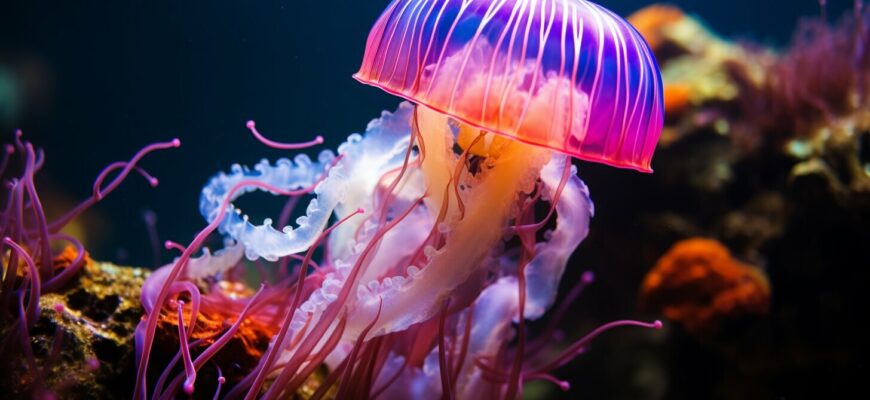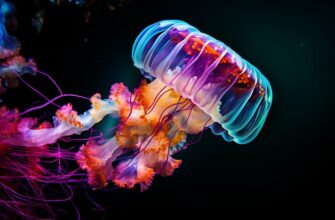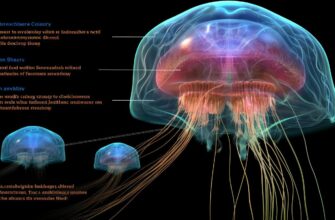Have you ever found yourself mesmerized by the ethereal movements of a jellyfish? These mysterious creatures are a wonder to behold, with their translucent bodies and delicate tentacles. But have you ever wondered if they have genders?
In this article, we will explore the anatomy of jellyfish and their reproductive processes. We will clarify the difference between sexes and genders and discuss whether jellyfish have distinct genders or not. We’ll also delve into the intricacies of jellyfish reproduction, including the role of gametes and the environmental factors that can influence it. And finally, we’ll answer some of the most frequently asked questions about jellyfish genders.
If you’re ready to dive into the fascinating world of jellyfish reproduction, keep reading!
- Understanding Jellyfish Anatomy
- Reproductive Organs
- Sexes vs. Genders: Clarifying the Terminology
- Reproduction in Jellyfish: A Complex Process
- Asexual Reproduction in Jellyfish
- Sexual Reproduction in Jellyfish
- The Role of Gametes in Jellyfish Reproduction
- Environmental Factors Affecting Jellyfish Reproduction
- Jellyfish and Evolutionary Adaptations
- FAQs About Jellyfish Genders
- Do male and female jellyfish look different?
- Can jellyfish change genders?
- Do jellyfish have sexes?
- How do jellyfish reproduce?
- Do jellyfish lay eggs?
- What environmental factors can affect jellyfish reproduction?
- Can jellyfish reproduce all year round?
Understanding Jellyfish Anatomy
Jellyfish are fascinating creatures with unique anatomy that sets them apart from other marine animals. These gelatinous creatures have a bell-shaped body with long, trailing tentacles that they use to catch prey. But what about their reproductive organs?
When it comes to jellyfish reproduction, things can get a little confusing. Unlike mammals, jellyfish do not have distinct genders or sexes. Instead, they have a complex reproductive system that allows them to reproduce both sexually and asexually.
| Types of Reproduction | Description |
|---|---|
| Asexual Reproduction | Involves the jellyfish cloning itself, producing genetically identical offspring. |
| Sexual Reproduction | Involves the combining of genetic material from two different jellyfish to produce a new, genetically unique offspring. |
During sexual reproduction, jellyfish release both eggs and sperm into the water, where fertilization occurs. The fertilized eggs then develop into larvae, which eventually settle on the ocean floor and form new jellyfish.
While jellyfish may not have distinct genders, they do have reproductive roles. Some jellyfish produce only eggs, while others produce only sperm. Others still are hermaphrodites, producing both eggs and sperm.
Reproductive Organs
Jellyfish reproductive organs are located in the gastrovascular cavity, which is the central cavity of their body. This cavity is used for digestion, but it also serves as a reproductive chamber.
The gonads, or reproductive organs, of jellyfish are found on the radial canals, which are the branching tubes that extend from the gastrovascular cavity. These canals allow nutrients and oxygen to be transported throughout the jellyfish’s body, as well as providing a location for the gonads to develop.
Overall, the reproductive system of jellyfish is complex and fascinating, due to the different methods of reproduction and their lack of distinct genders. Understanding the anatomy and reproductive habits of jellyfish is a step towards appreciating these mesmerizing creatures.
Sexes vs. Genders: Clarifying the Terminology
Before delving deeper into the topic of jellyfish genders, it is important to clarify the terminology used. While the terms “sex” and “gender” are often used interchangeably, they actually refer to different things.
Sex refers to the biological differences between males and females, such as reproductive organs and chromosomes. Gender, on the other hand, is a social construct that relates to the roles, behaviors, and expectations associated with being male or female in a particular culture or society.
While jellyfish may not have distinct genders, they may still have sexes or reproductive roles. By understanding the distinction between sex and gender, we can better appreciate the complexities of jellyfish reproduction and how it relates to the larger conversation about gender and sex in the animal kingdom.
Reproduction in Jellyfish: A Complex Process
Jellyfish have a unique and complex reproductive process that differs from that of most other animals. The life cycle of a jellyfish consists of several stages, including the medusa stage (adult) and the polyp stage (juvenile). In this section, we will explore the various methods of reproduction in jellyfish and their intricate life cycle.
Asexual Reproduction in Jellyfish
Jellyfish are capable of asexual reproduction through a process called budding. This involves the development of small polyps that eventually break away from the parent medusa to become separate individuals. The newly formed jellyfish will be identical to the parent and will have the same genetic material.
In some cases, jellyfish can also undergo a process called strobilation, which involves the budding of multiple juvenile medusae from a single polyp. This can result in a colony of genetically identical jellyfish.
Sexual Reproduction in Jellyfish
Jellyfish also reproduce sexually, although they do not have distinct genders or sexes. Instead, all jellyfish are capable of producing both eggs and sperm. During sexual reproduction, males and females will release their gametes into the water, where fertilization occurs.
After fertilization, the embryo develops into a free-swimming larva, which eventually settles on a substrate and becomes a polyp. The polyp will then grow and eventually produce new medusae through asexual reproduction or strobilation.
The process of jellyfish reproduction is complex and fascinating, highlighting the unique adaptations of these mesmerizing creatures.
The Role of Gametes in Jellyfish Reproduction
Jellyfish reproduction is a complex process that involves the production and fusion of gametes, which are the reproductive cells responsible for creating new jellyfish offspring. There are two types of gametes: sperm and eggs. While some jellyfish may produce both types of gametes, others may only produce one type.
The gametes of jellyfish are produced in their gonads, which are specialized reproductive organs located in their bell. The gonads release the gametes into the surrounding water, where fertilization can occur.
| Type of Gamete | Description |
|---|---|
| Sperm | Male gamete that is usually smaller in size than eggs. Sperm have a flagellum that helps them swim towards the eggs for fertilization. |
| Eggs | Female gamete that is larger in size than sperm. Eggs contain yolk, which provides nutrients for the developing embryo. |
The fusion of sperm and eggs leads to the formation of a zygote, which is the first stage of jellyfish development. This zygote will eventually develop into a larva, which will then grow into an adult jellyfish.
It’s important to note that while jellyfish may not have distinct genders, they do have reproductive roles. Male and female gametes are necessary for sexual reproduction in some jellyfish species, while others can reproduce asexually or through a combination of sexual and asexual reproduction.
Fun fact: Some jellyfish, such as the Moon Jellyfish, are capable of reproducing both sexually and asexually, depending on environmental factors!
Environmental Factors Affecting Jellyfish Reproduction
Jellyfish reproduction is a complex process that can be influenced by many environmental factors. Understanding these factors can help us better predict and manage jellyfish populations. Here are some of the key environmental influences that can affect jellyfish reproduction:
| Factor | Impact on Jellyfish Reproduction |
|---|---|
| Temperature | Temperature can impact the timing and success of jellyfish reproduction. In general, warmer temperatures can lead to faster development and earlier spawning, while colder temperatures can delay reproduction. Some species may also have temperature preferences for spawning. |
| Salinity | Salinity can impact the ability of jellyfish to produce healthy eggs and sperm. In some cases, high salinity levels can cause infertility and reduce reproductive success. |
| Food Availability | Jellyfish reproduction can be affected by the abundance and quality of their food source. If prey is scarce or of low quality, jellyfish may delay reproduction or produce fewer offspring. |
Research has also shown that other factors, such as pollution and ocean acidification, can impact jellyfish reproduction. It’s important for us to continue studying these factors and their effects on jellyfish, as they play a crucial role in marine ecosystems and can have significant economic and environmental impacts.
Jellyfish and Evolutionary Adaptations
Jellyfish have been around for millions of years, and their reproductive strategies have evolved over time. Through natural selection, jellyfish have developed unique characteristics and behaviors that ensure successful reproduction.
One adaptation is the ability to switch between sexual and asexual reproduction depending on the environmental conditions. When resources are abundant, jellyfish may reproduce sexually to increase genetic diversity. However, when resources are scarce, they may switch to asexual reproduction to maximize the number of offspring produced.
Another adaptation is the ability to clone themselves when threatened. If a jellyfish is injured or attacked, it can use its tentacles to produce new polyps that can grow into genetically identical adult jellyfish.
Jellyfish have also developed intricate life cycles with different stages of development. Some species have a polyp stage, where the jellyfish attach themselves to surfaces and reproduce asexually, before maturing into adult medusae that reproduce sexually.
Additionally, many jellyfish have unique reproductive behaviors. For example, some jellyfish release their gametes into the water, while others transfer their gametes directly to the female’s mouth.
The various adaptations that jellyfish have developed have allowed them to survive and thrive in a diverse range of environments. By continuing to study their reproductive strategies, we can gain a better understanding of these fascinating creatures and their place in our ecosystem.
FAQs About Jellyfish Genders
As jellyfish don’t have distinct genders, it’s common to have questions about their reproductive roles. Here are some of the most frequently asked questions about jellyfish genders:
Do male and female jellyfish look different?
No, there are no physical differences between male and female jellyfish. The only way to determine their sex is by examining their reproductive organs.
Can jellyfish change genders?
Jellyfish have the ability to switch their reproductive roles between male and female, but this is not the same as changing genders. Rather, they can produce both male and female gametes at different points in their life cycle.
Do jellyfish have sexes?
While jellyfish may not have distinct genders, they do have reproductive roles or sexes. Some species may have separate sexes, while others can have both male and female reproductive organs.
How do jellyfish reproduce?
Jellyfish can reproduce in a variety of ways, including sexual and asexual reproduction. During sexual reproduction, male and female gametes unite to form a zygote, which develops into a larva. Asexual reproduction involves budding, where new individuals form from the existing polyp or medusae.
Do jellyfish lay eggs?
Jellyfish do not lay eggs in the same way as other animals. Instead, they release sperm and eggs into the water, where fertilization occurs externally. The fertilized eggs develop into free-swimming larvae that eventually settle on a substrate to form a polyp.
What environmental factors can affect jellyfish reproduction?
Temperature, salinity, and food availability can all impact jellyfish reproduction. Some species require specific conditions to reproduce, while others can adapt to a range of environments.
Can jellyfish reproduce all year round?
Some jellyfish species reproduce continuously throughout the year, while others have specific breeding seasons. The timing of reproduction can also depend on environmental factors such as temperature and food availability.
We hope this has cleared up some of the confusion around jellyfish genders and reproductive roles. Remember, while they may not have distinct genders, jellyfish are still fascinating creatures with complex reproductive strategies.









